DRAWINGS
EVERYTHING EXISTS IN DARKNESS QUADRILOGY (2015-22)
Everything Exists in Darkness Quadrilogy (2015-22), drawing installation of four large-scale drawings (each 2.5m x 2.7m) - pencil crayon on black paper, aluminium pole, steel brackets, expanders, velcro and chain. Centre for Reworlding presents: Resurgence, Incinerator Art Gallery, Aberfeldie, VIC, Australia (June/July 2022). Photo: Lucy Foster
A World Worthy of its Children (2022) - When All Else Fails (2017) - Bad Smell of Extinction (2015) - Myth of Progress (2015)
Updated text from the exhibition Centre for Reworlding presents: RESURGENCE (2022)
Everything Exists in Darkness Quadrilogy (2015-2022) began after the release of the Intergovernmental Panel on Climate Change’s 2014 AR5 Synthesis report on climate adaptation, impacts and vulnerability that identified with 95% certainty that humans were driving global warming and that failures to secure a legally binding climate agreement to curb CO2 emissions were likely to cause tipping points in the climate system.
Jen Rae uses drawing as a mnemonic device* to visually synthesise complex data related to the long-emergency of climate change and uncertain futures. The act of drawing is a form of perpetual responsiveness, creating a tangible bridge between the unknown and the everyday, and making visible what may be latent in memory and the realm of the imagination. It is a process-based approach to drawing that moves between observation and synthesising data, studying the visible realm of the present, referencing the past, and projecting representations of imagined futures. She states that ‘everything exists in darkness, it’s just a matter of shining the light into those spaces’.
The drawing Myth of Progress (2015) pulls ideas from the historical understanding of myths as a way of making sense of our post-Industrial progression, and as a means of comprehending some of the associated complexities.
It explores the ‘paradox of progress’ through an anthropocentric lens by juxtaposing human ‘achievements’ resting precariously on the backs of sheep. In the drawing, there are references to some of our collective achievements in transportation, architecture and agriculture contrasted with suggestions of excess, exploitation and pollution. Sheep are also significant symbols in mythology (e.g. The Golden Fleece) and religion (e.g. Agnus Dei, wolf in sheep’s clothing, sacrificial lamb, etc.), but also in Australian history and vernacular (e.g. ‘riding on the sheep’s back, jumbuck, dag, etc.). Here the sheep are blindfolded and unconscious piled upon one another (like timber) on their way to slaughter – nothing more that raw material (e.g. milk, wool and meat) for human production and consumption. Live export trade and industrial feedlots now exist now satiate a massive and growing global population – a by-product of ‘progress’ in animal husbandry resulting from the modern agricultural revolution. The raven is the wise seer that sits atop the chaos of warnings ignored by the children of the Enlightenment.
The drawing, Bad Smell of Extinction (2015) progresses these ideas into an almost fatalistic representation of anthropogenic fallout. Here, a feller buncher rests atop a polar bear, both caught in a moment of suspended animation on the verge of decay. The feller buncher, the quintessential tool of forestry progress is symbolically represented as a decomposing trophy of the Anthropocene. Metaphorical references are made to ideas of future blindness, the ‘progress web of mania’ and the cultural myths that may lead us toward our own extinction. Nature begins to wrap around the collapsed vestiges of human architecture and Foucalt’s pendulum is reminder that the earth will continue to spin with or without the human species.
When All Else Fails (2017) is the third drawing in the quadrilogy exploring the plight of the human condition in the aftermath of societal collapse through the eyes of a lone climate refugee facing an uncertain future floating in darkness. The fight is lost Displaced. Movement on water is the refugee’s only hope for survival as the weight of the past hangs precariously above.
The quadrilogy ends with A World Worthy of its Children (2022), a line adapted from legendary cellist Pablo Casal’s book Joy and Sorrow. It imagines a world where a child emerges from two worlds constructed by inverted Métis-style teepees where they have been sheltered in refugium as climate impacts spread across the globe. The style is intentional in its simplicity compared to the others. Everything exists in darkness. Radical hope lies in our capacity to imagine and fight for a future worthy of our children and future ancestors.
Myth of Progress (2014) and The Bad Smell of Extinction (2015), RMIT Gallery (photo: Sarah Fuller)
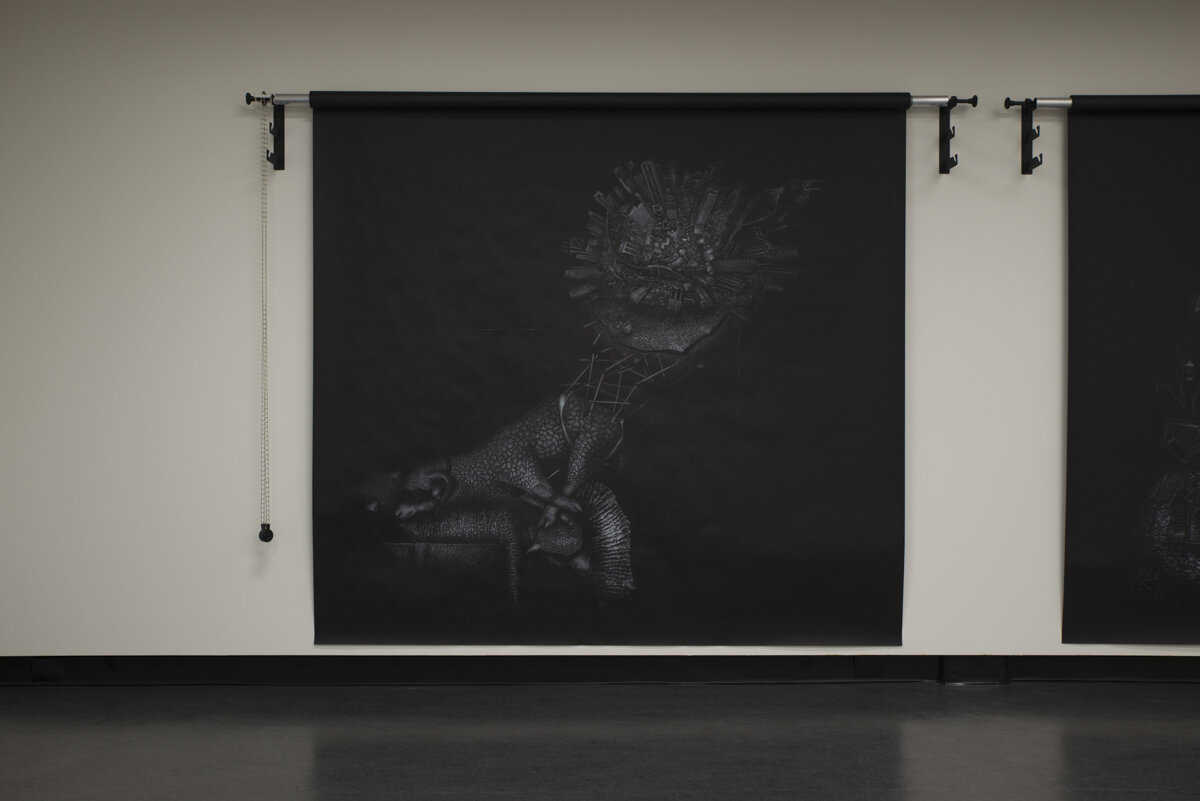
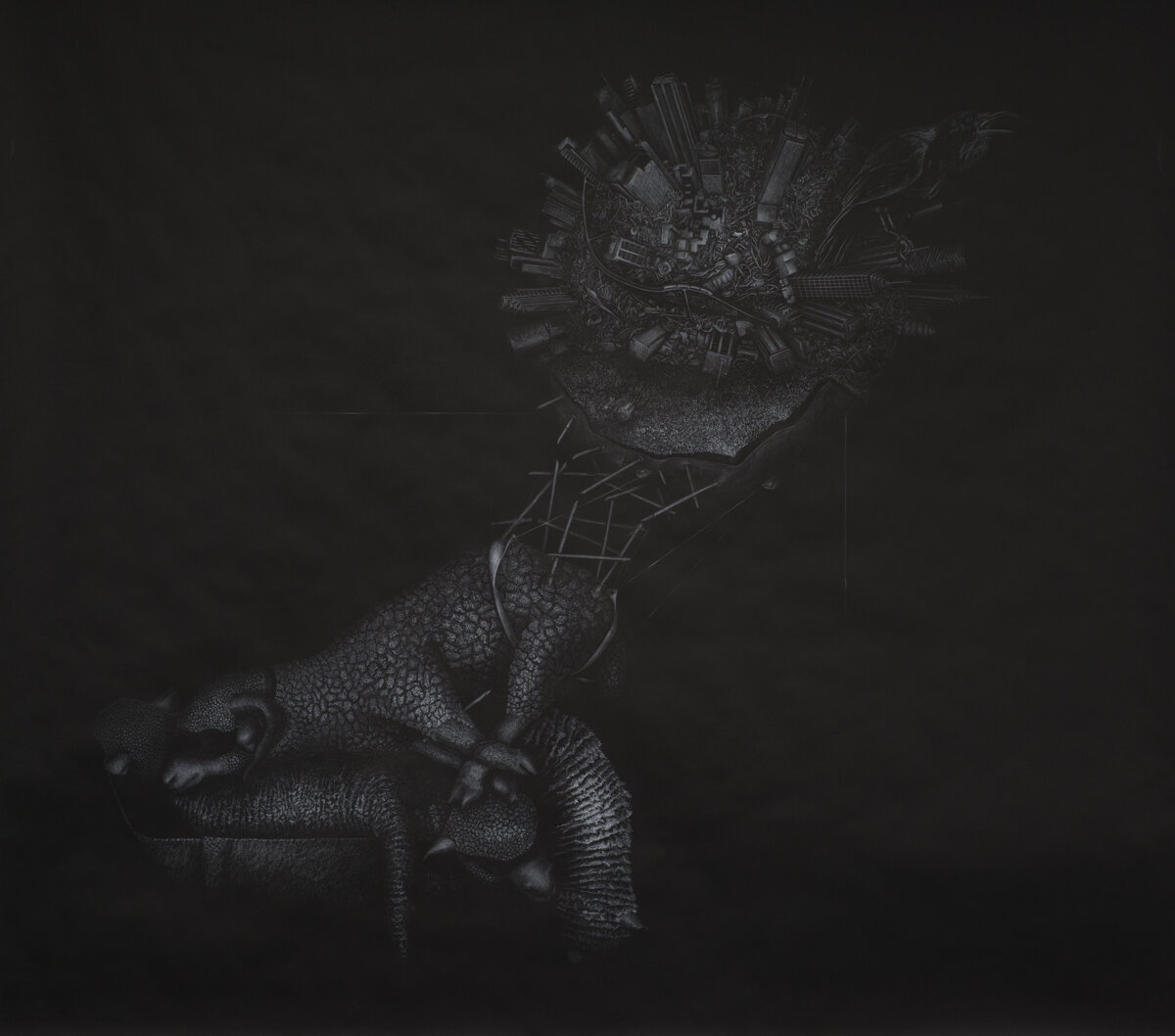
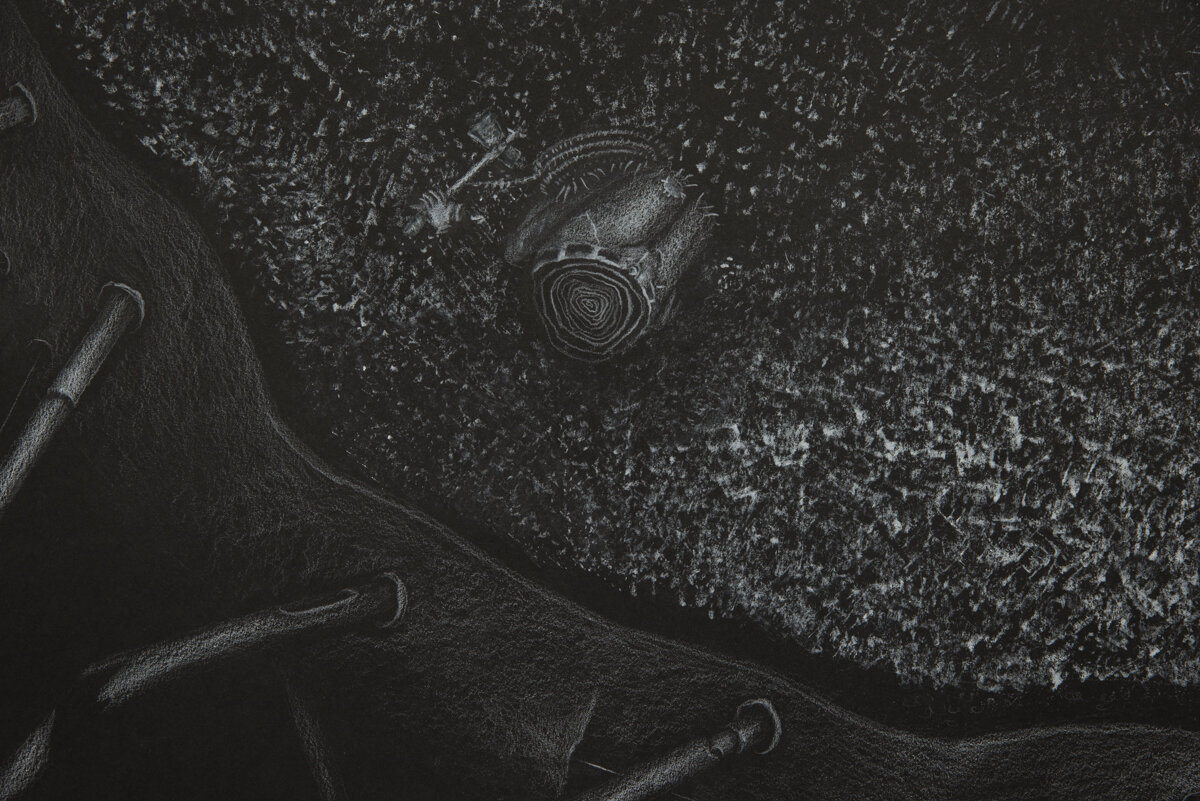
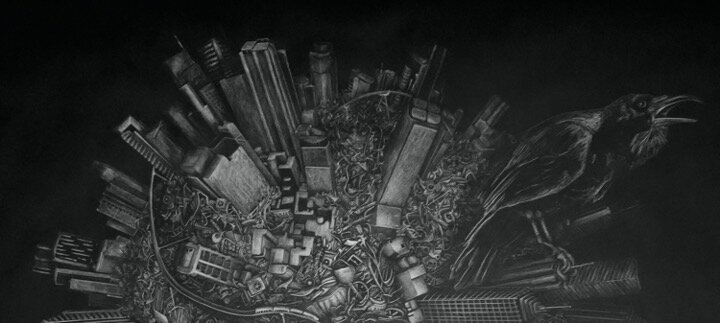
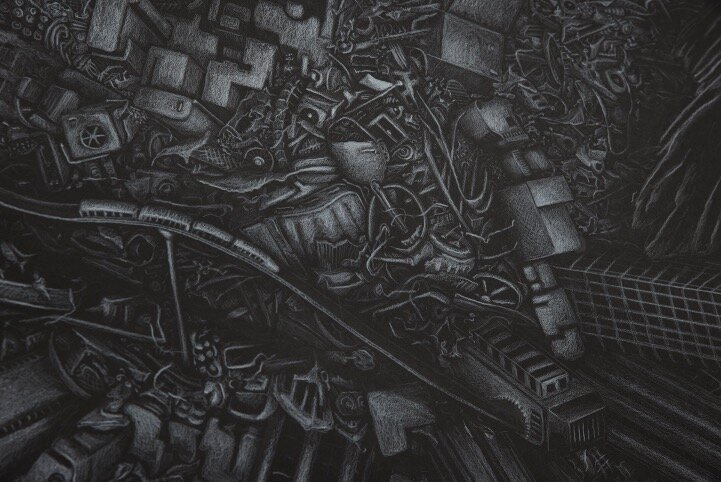
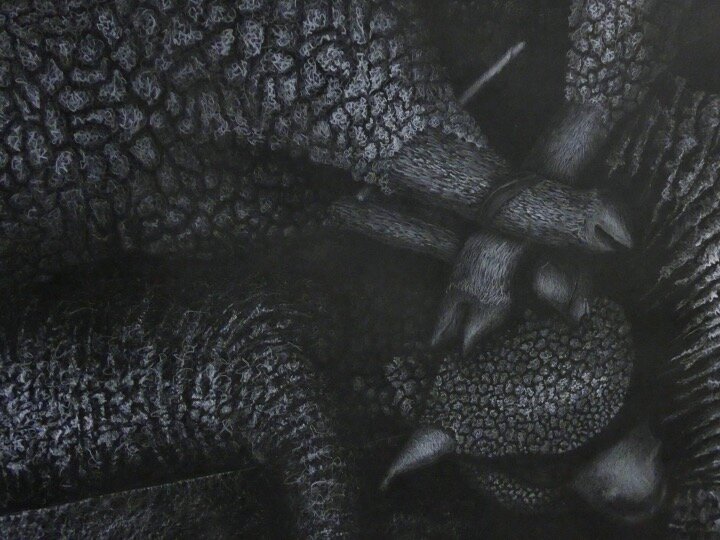
MYTH OF PROGRESS (2015)
Pencil crayon on black paper, 2.5 x 2.7m
The drawing Myth of Progress (2015) pulls ideas from the historical understanding of myths as a way of making sense of our post-Industrial progression, and as a means of comprehending some of the associated complexities.
It explores the ‘paradox of progress’ through an anthropocentric lens by juxtaposing human ‘achievements’ resting precariously on the backs of sheep. In the drawing, there are references to some of our collective achievements in transportation, architecture and agriculture contrasted with suggestions of excess, exploitation and pollution. Sheep are also significant symbols in mythology (e.g. The Golden Fleece) and religion (e.g. Agnus Dei, wolf in sheep’s clothing, sacrificial lamb, etc.), but also in Australian history and vernacular (e.g. ‘riding on the sheep’s back, jumbuck, dag, etc.). Here the sheep are blindfolded and unconscious piled upon one another (like timber) on their way to slaughter – nothing more that raw material (e.g. milk, wool and meat) for human production and consumption. Live export trade and industrial feedlots now exist now satiate a massive and growing global population – a by-product of ‘progress’ in animal husbandry resulting from the modern agricultural revolution. The raven is the wise seer that sits atop the chaos of warnings ignored by the children of the Enlightenment.
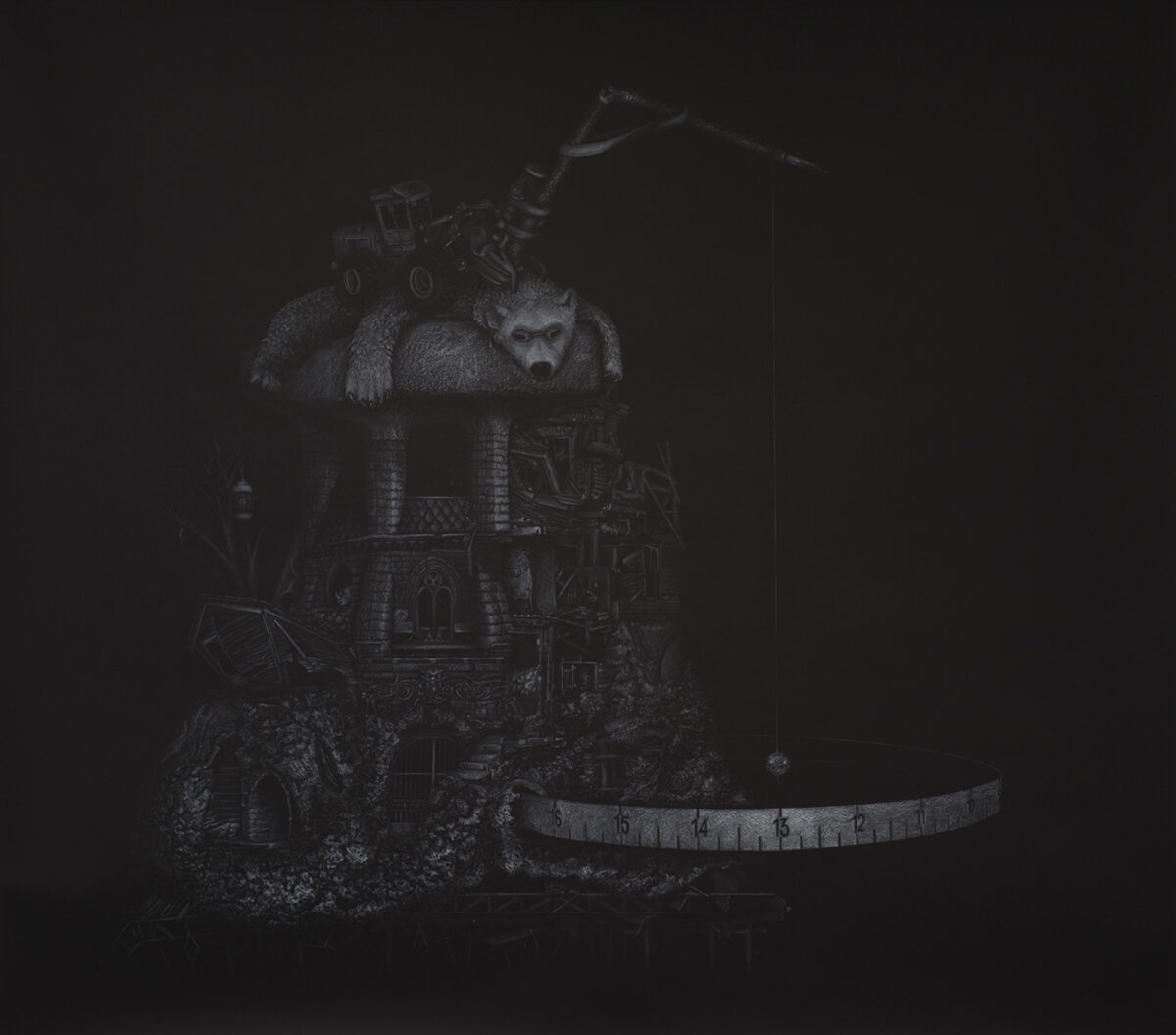
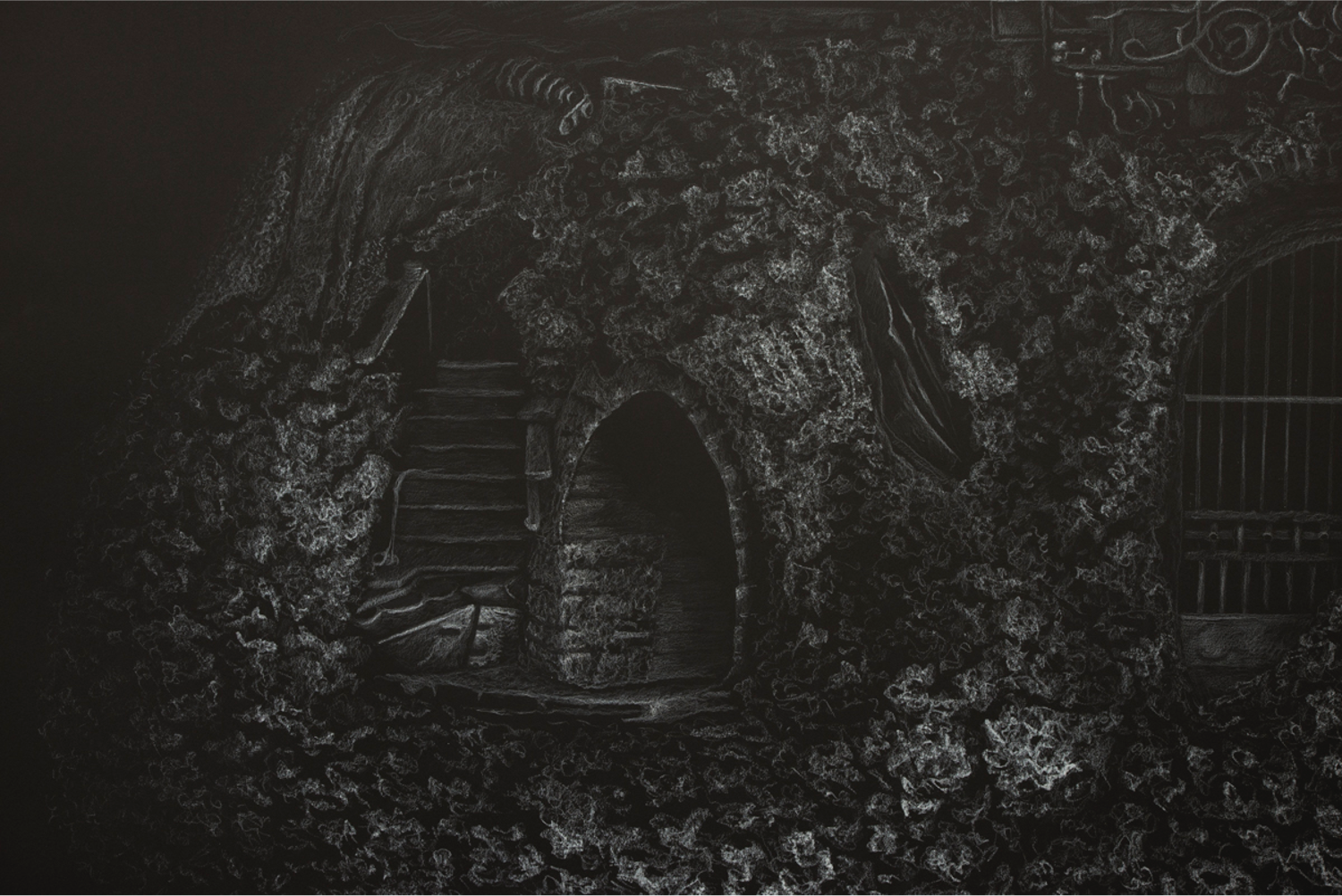
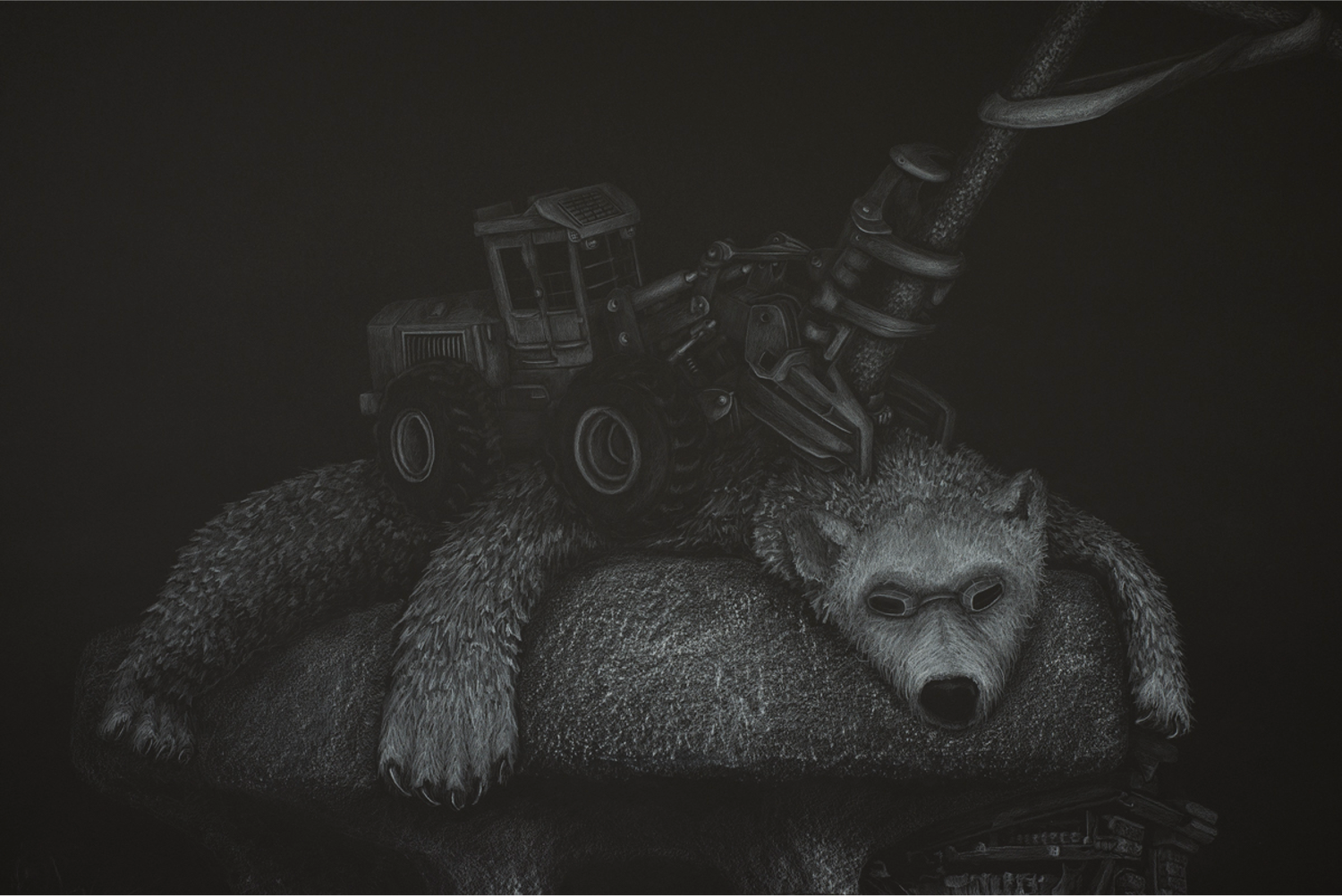
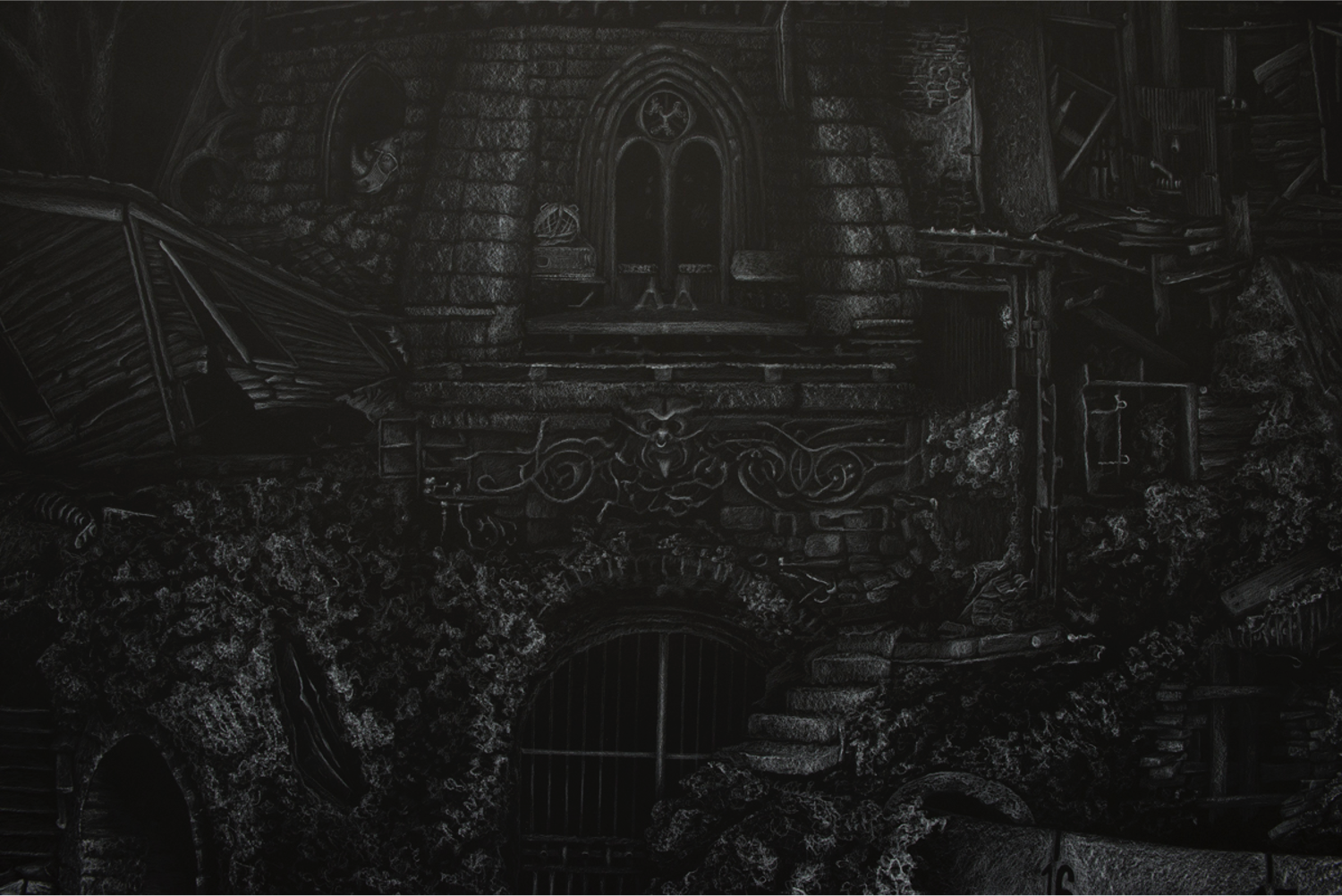
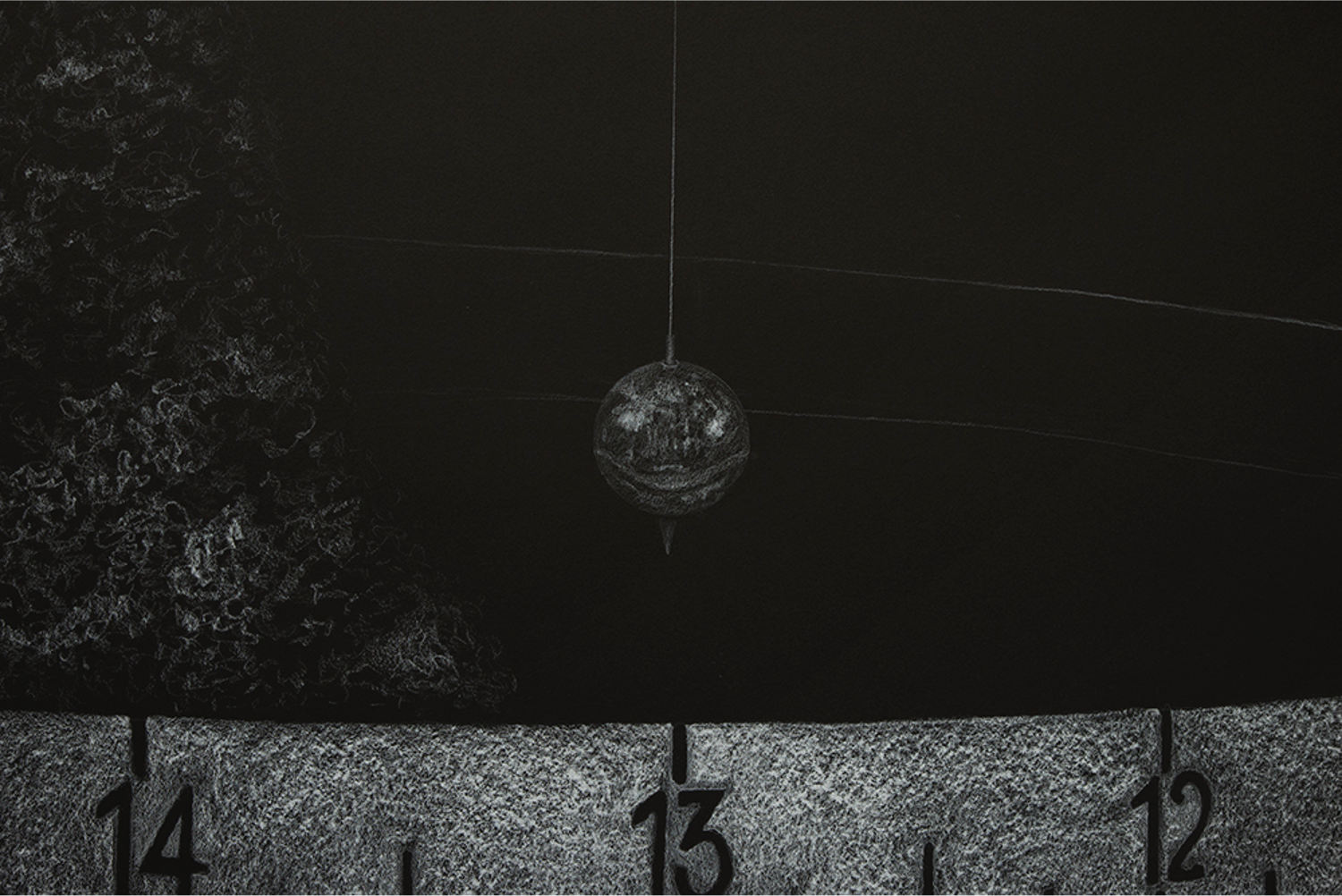
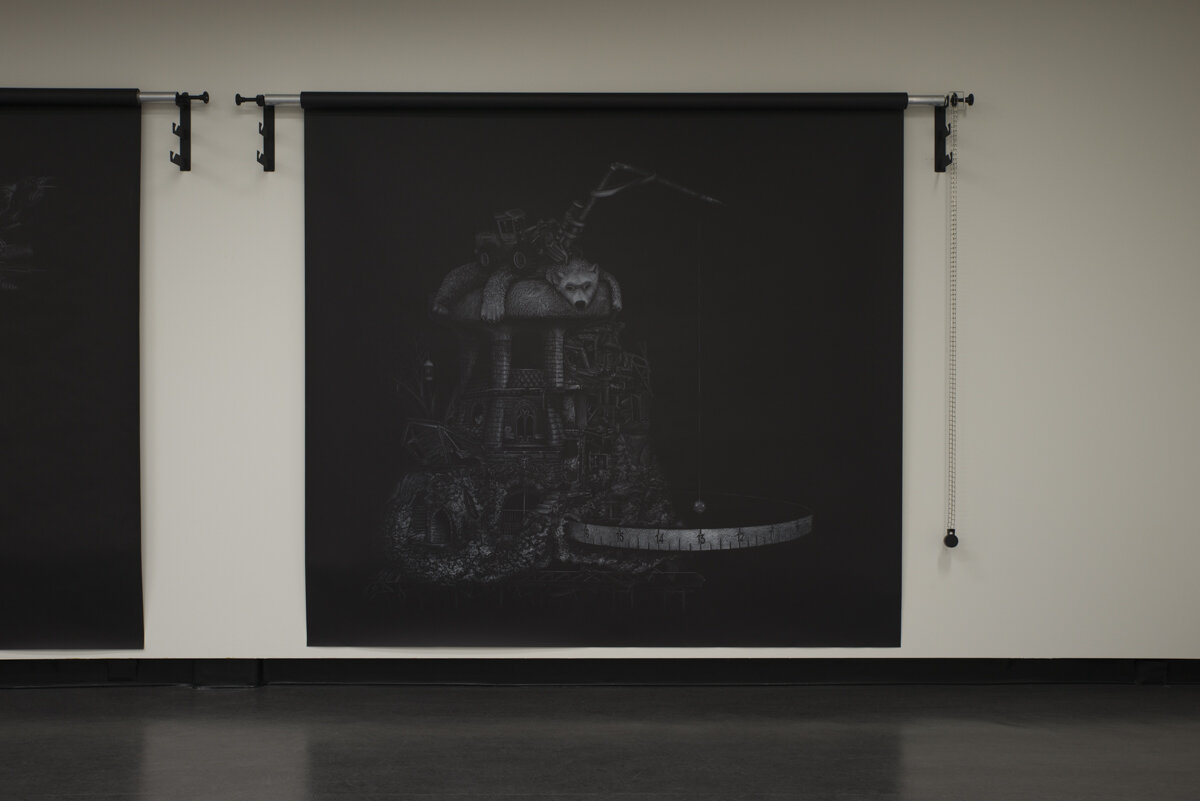
BAD SMELL OF EXTINCTION (2015)
Pencil crayon on black paper, 2.5 x 2.7m
The drawing, Bad Smell of Extinction (2015) progresses these ideas into an almost fatalistic representation of anthropogenic fallout. Here, a feller buncher rests atop a polar bear, both caught in a moment of suspended animation on the verge of decay. The feller buncher, the quintessential tool of forestry progress is symbolically represented as a decomposing trophy of the Anthropocene. Metaphorical references are made to ideas of future blindness, the ‘progress web of mania’ and the cultural myths that may lead us toward our own extinction. Nature begins to wrap around the collapsed vestiges of human architecture and Foucalt’s pendulum is reminder that the earth will continue to spin with or without the human species.
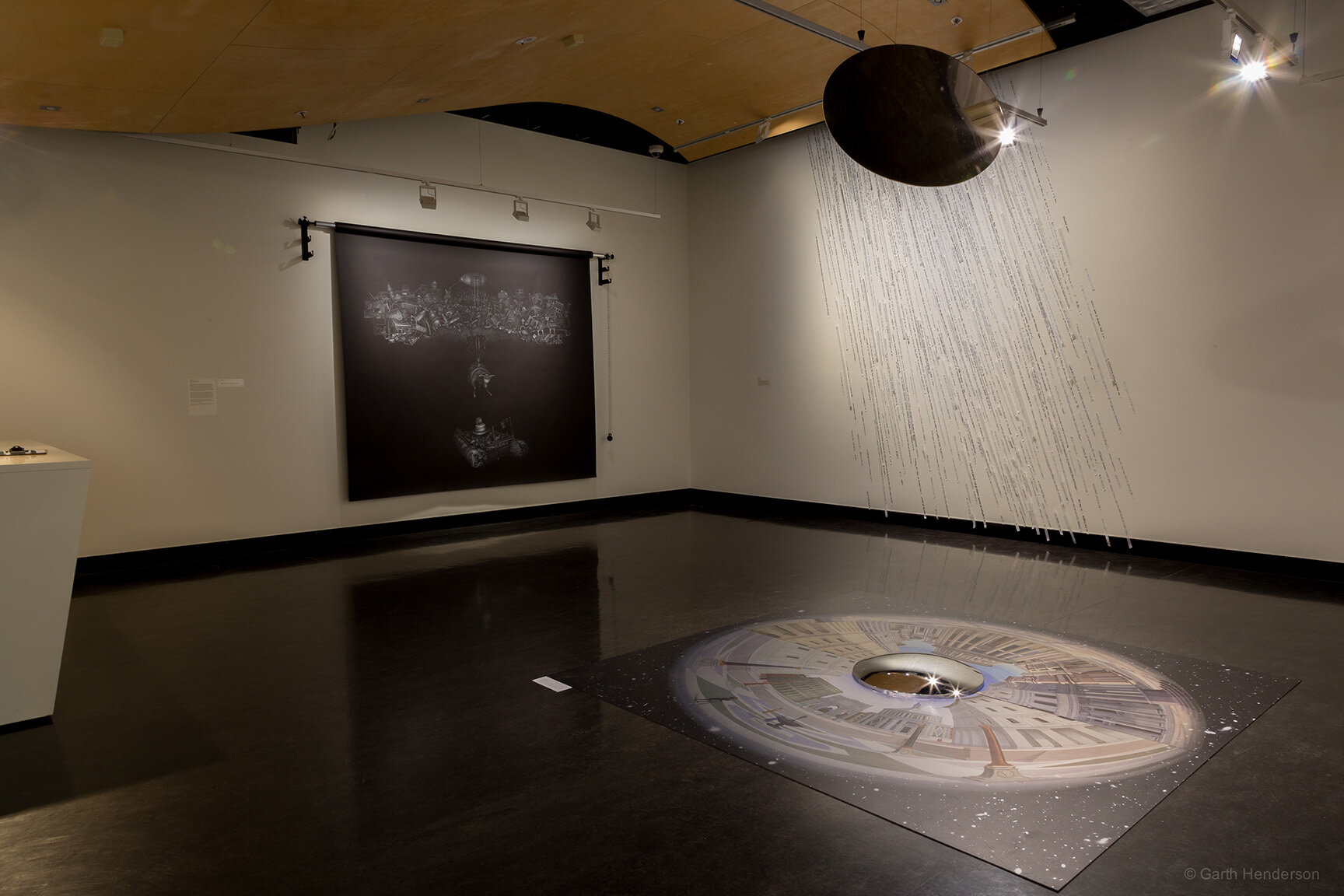
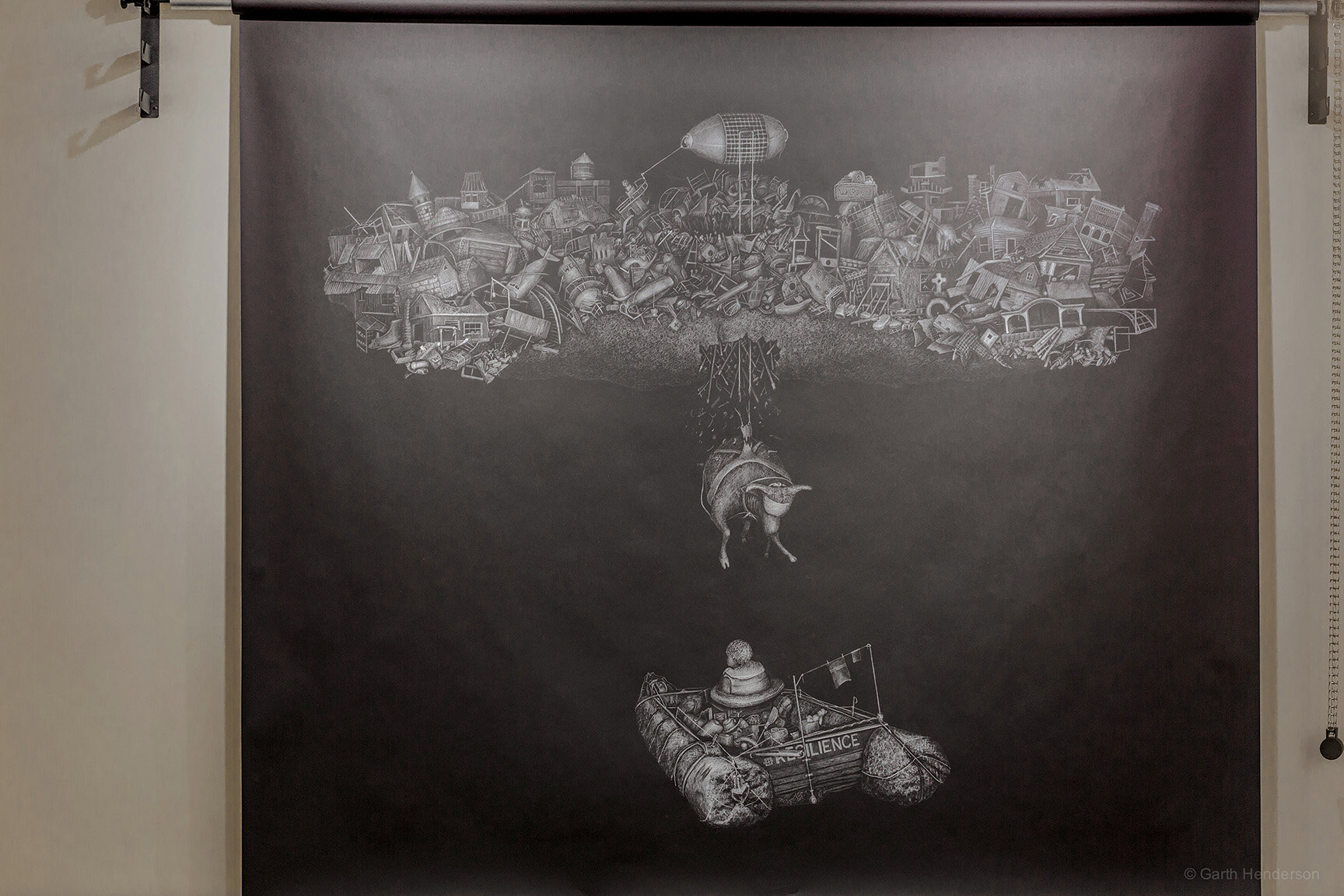
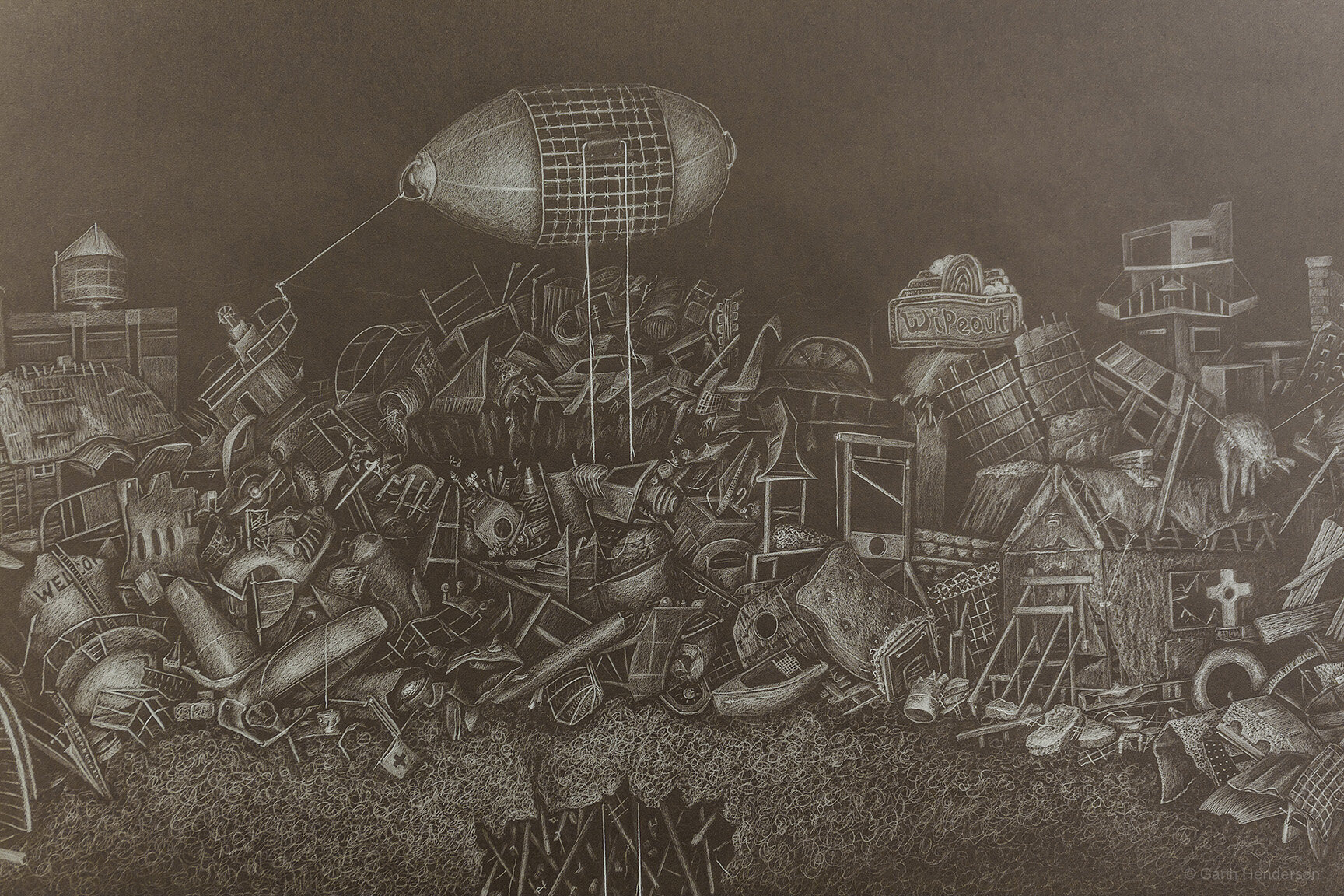
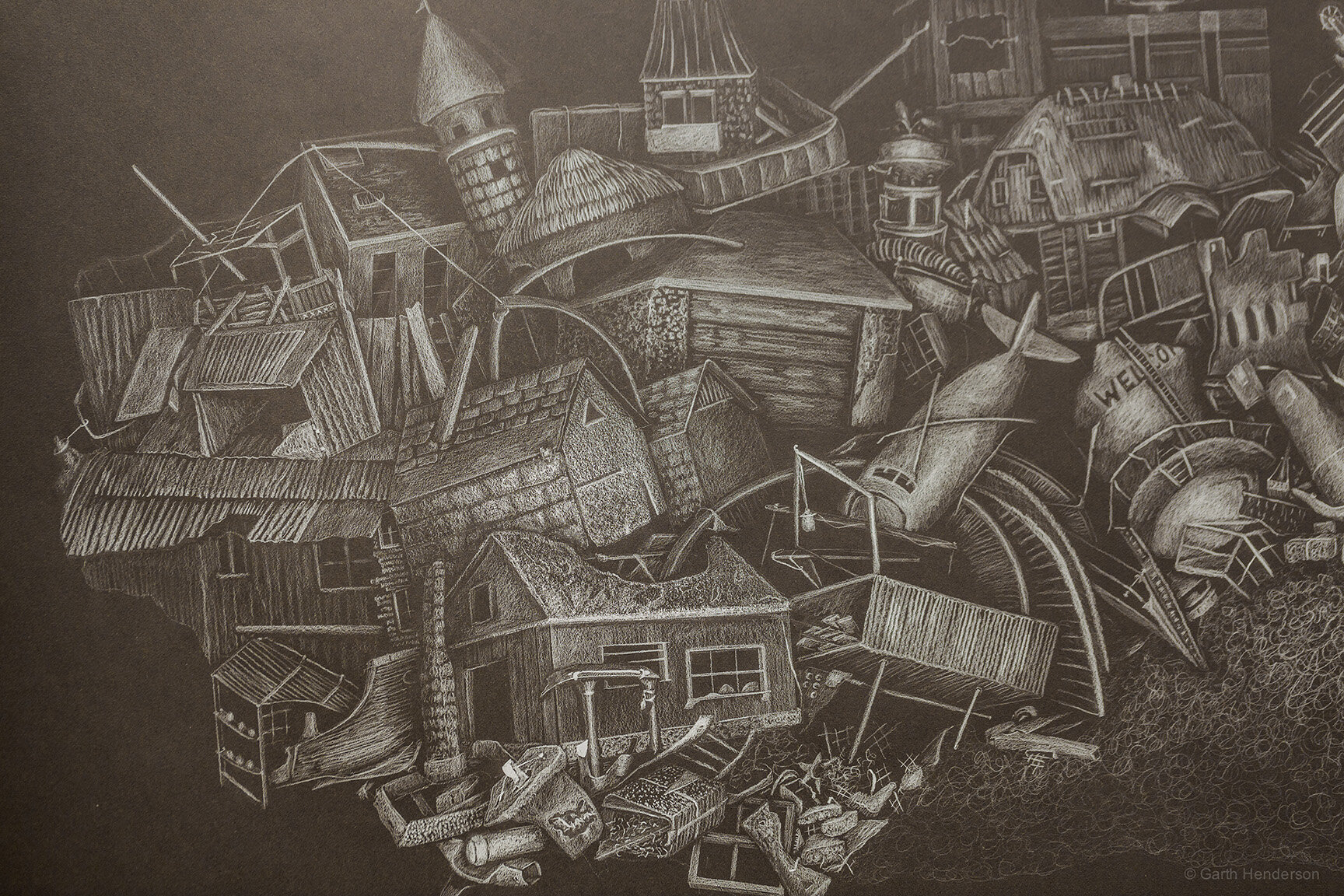
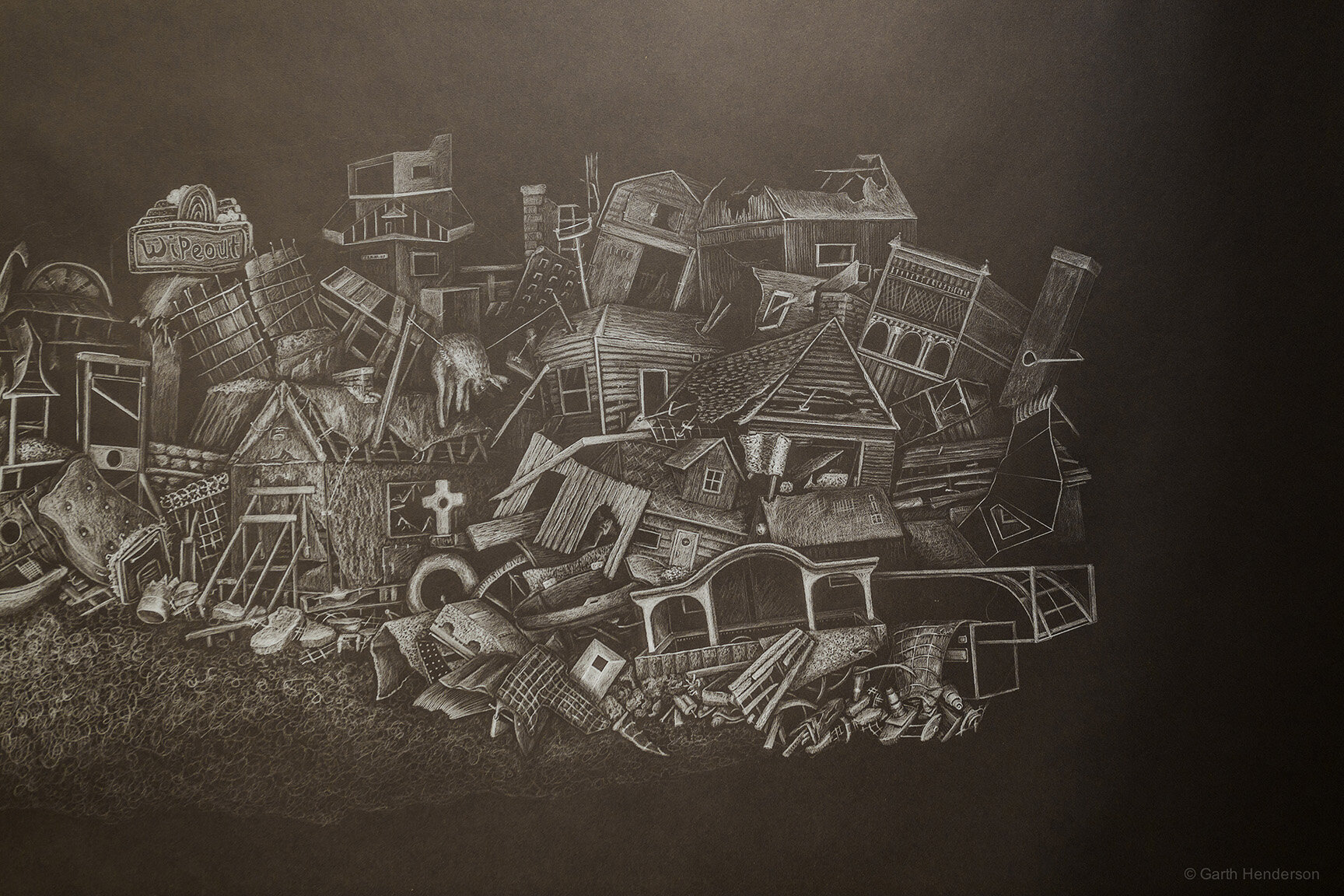
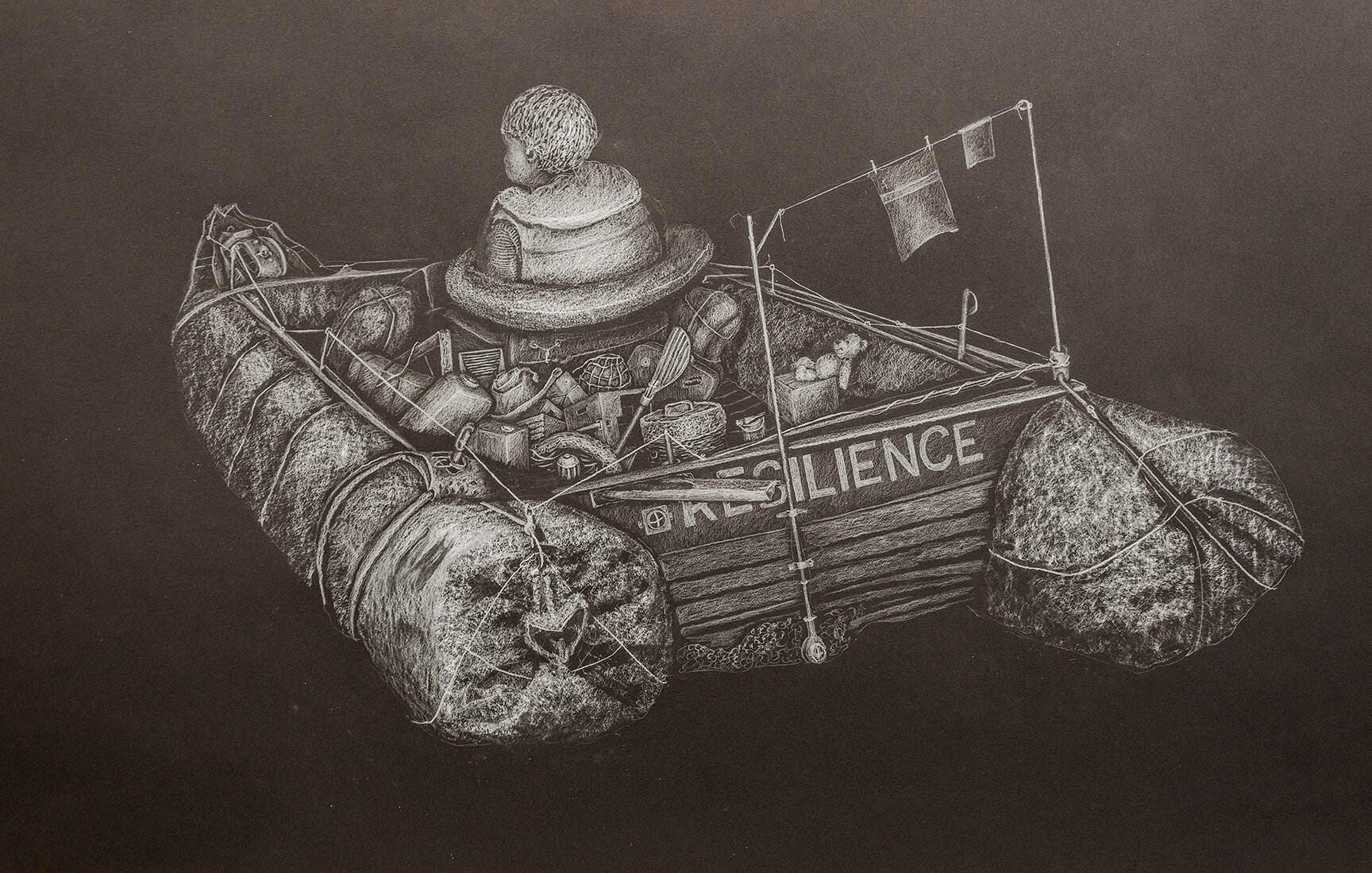
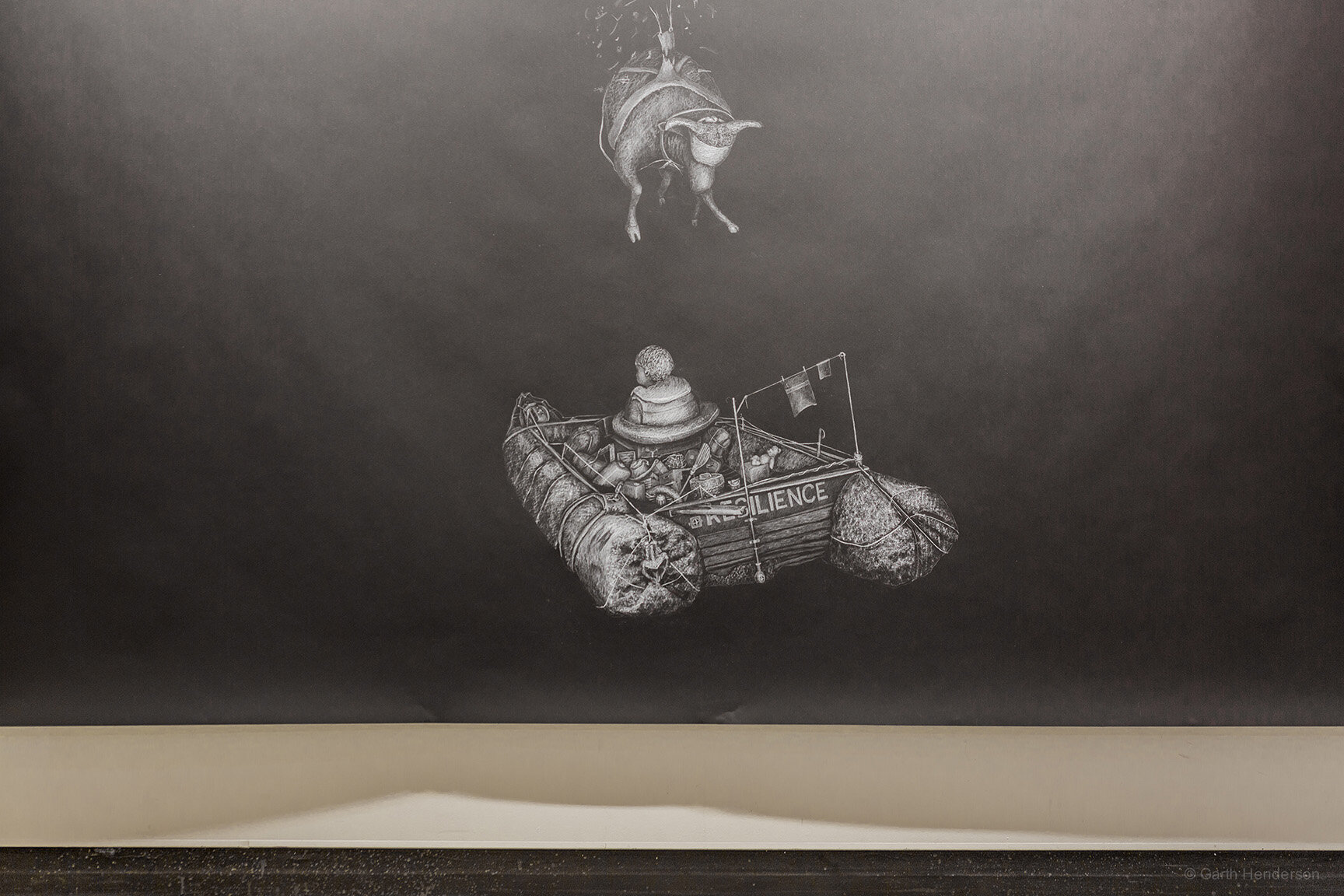
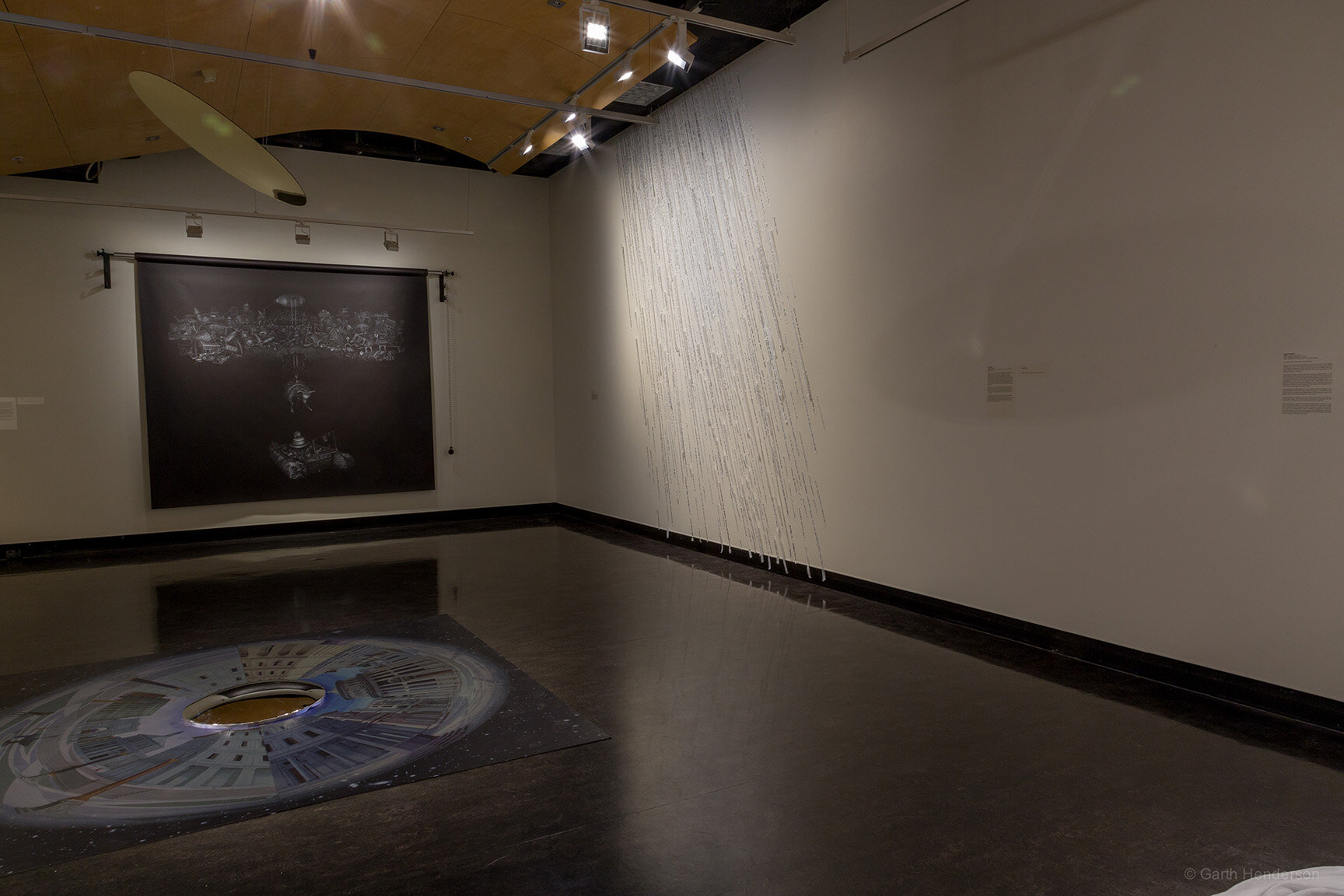
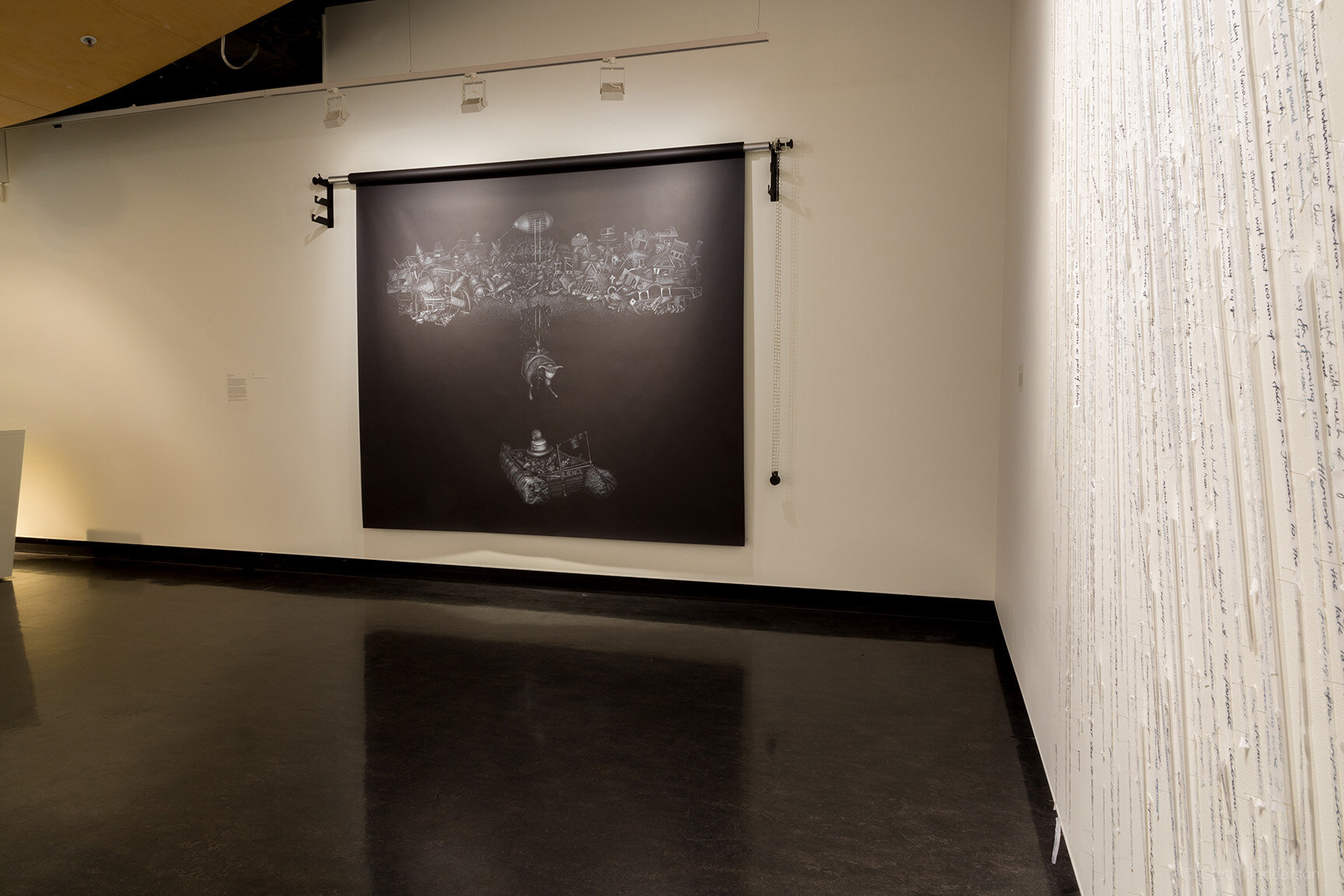
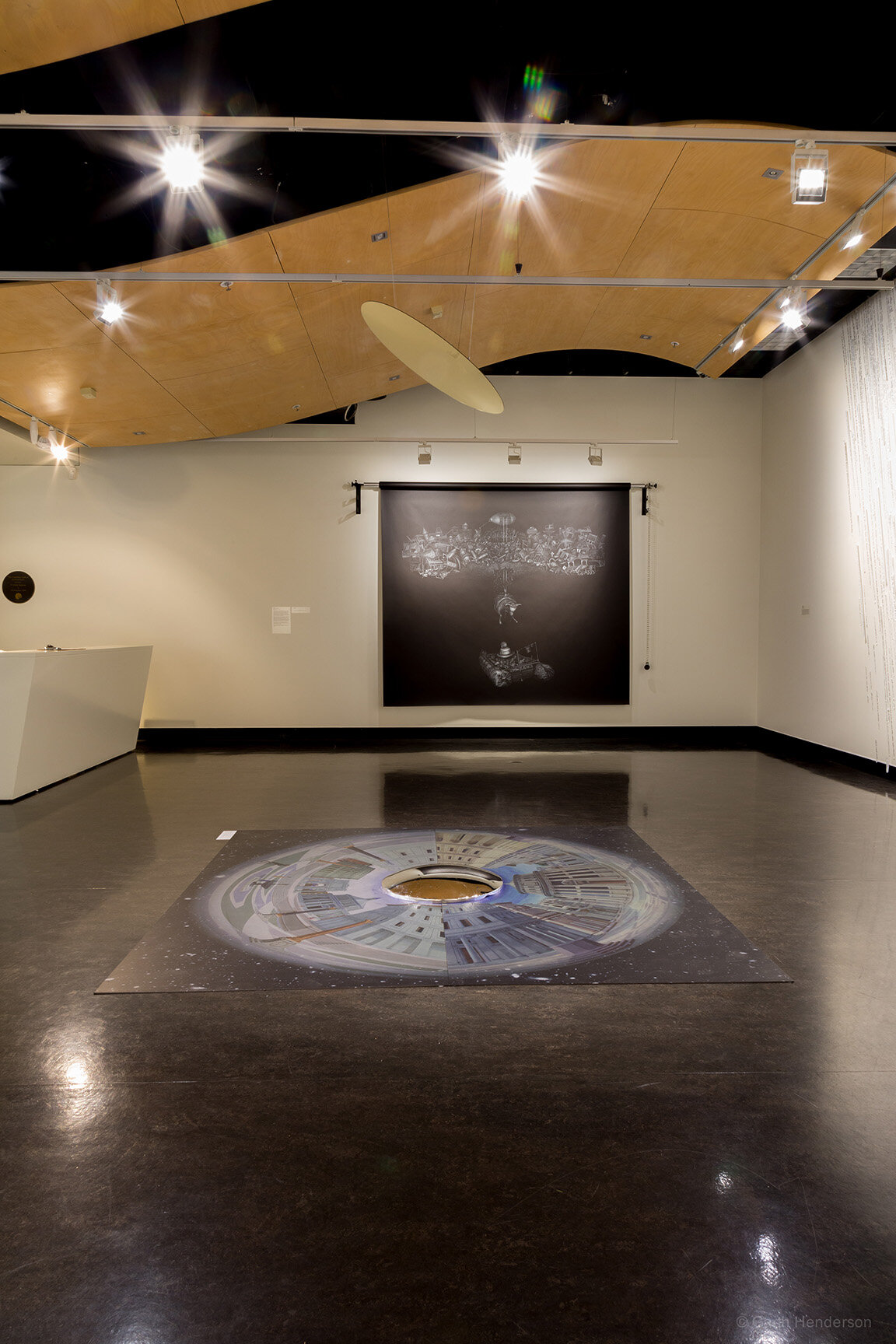
WHEN ALL ELSE FAILS (2017)
Pencil crayon on black paper, 2.5 x 2.7m
I use drawing as a mnemonic device* to visually synthesise complex data related to the long-emergency of climate change and uncertain futures. The act of drawing is a form of perpetual responsiveness, creating a tangible bridge between the unknown and the everyday, and making visible what may be latent in memory and the realm of the imagination. It is a process-based approach to drawing that moves between observation and synthesising data, studying the visible realm of the present, referencing the past, and projecting representations of imagined futures.
When All Else Fails is the third large-scale drawing of the Anthropocene Trilogy, a series of drawings that explore the plight of the human condition in a time of climate change. It follows The Myth of Progress (2015), a drawing that investigates the paradox of progress through an anthropocentric lens, by juxtaposing human ‘achievements’ resting precariously on the backs of non-human species; and The Bad Smell of Extinction (2015), a drawing that explores mortality in the aftermath of societal collapse, with only the vestiges of our civilisation remaining.
When All Else Fails finishes the trilogy by exploring the plight of a lone refugee facing an uncertain future in darkness. The fight is lost. Displaced. Movement on water is the refugee’s only hope for survival as the weight of the past hangs precariously above.
*A mnemonic device is simply a learning technique or means of visually organising, combining and storing information in the memory for retention.
Exhibited at the Counihan Gallery for the exhibition Flow in 2017. Catalogue.
A World Worthy of it’s Children (2022), pencil crayon on black paper (2.5 x 2.7m) Photo: Jorge de Araujo



